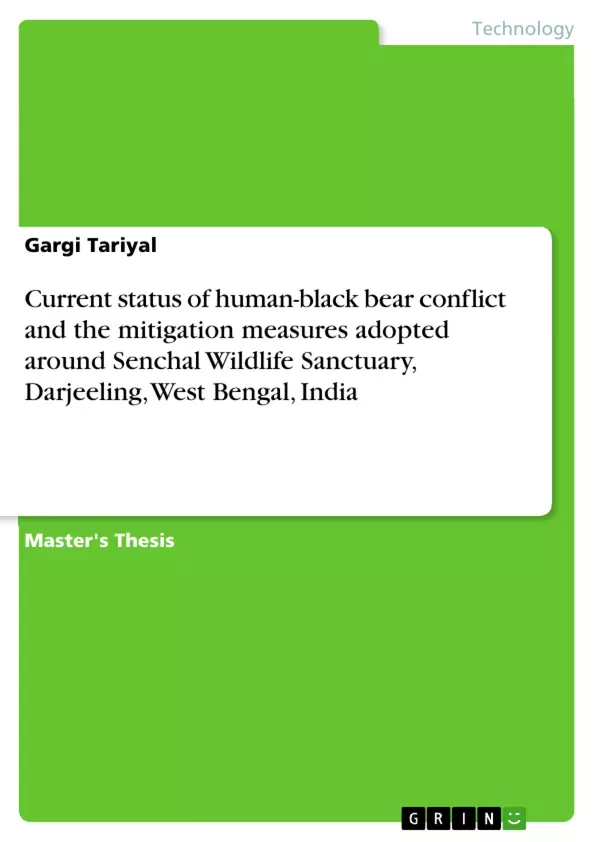Asiatic black bear (Ursus thibetanus) is one of the largest carnivores of Senchal Wildlife Sanctuary (WLS). Black bear-human conflict is a major concern throughout the eastern Himalayas and particularly in the Darjeeling district of West Bengal state. A study was undertaken to assess the Black bear-Human conflicts using Questionnaire surveys within the fringe villages of Senchal Wildlife Sanctuary (WLS), West Bengal during the period June-July 2013 by applying snowball-sampling technique. The black bear-human conflicts recorded were in three forms: crop raiding, livestock predation, human attacks and sometimes even death of humans. Crop damage was observed to be the most common type of conflict as reported by more than 80% of the respondents. The extent of crop damage was intense in the month of June-September, mainly concentrated along forest boundary areas which can be related to the cropping pattern and pre-hibernation period of black bears. Crop damage and livestock damage was estimated for the areas surveyed. The traditional methods adopted by the villagers to scare or chase off bear included, shouting, drumming empty tin, Bamboo netted fencing , keeping guard dogs and handmade fire mashals (Pultho). However these methods are hardly effective because their applicability lies when the villagers know about the presence of bears in their fields, which is very rare as most of the bear attacks occur during late night hours, when the villagers are in sound sleep. Provision for immediate compensation for crop damage and livestock insurance schemes was suggested by the villagers to mitigate HBC. The willingness of the villagers to adapt to measures to mitigate HBC was found to be directly related to the cooperation provided by the forest officials and NGO’s.
Inhaltsverzeichnis (Table of Contents)
- Abstract
- Chapter 1: Introduction
- 1.1 Background
- 1.2 Study objectives
- Chapter 2: Literature review
- 2.1 Human Wildlife Conflict
- 2.2 General Account on Asiatic black bear
- (a) Habitat and Ecology
- (b) Geographic distribution
- 2.3 Human-Black bear Conflict
- Chapter 3: Study area
- 3.1 General view
- 3.2 Climate
- 3.3 Forest type
- 3.4 Soil
- 3.5 People and communities
- Chapter 4: Methodology
- (a) Method
- (b) Sampling Method
- (c) Material Requirements
- Chapter 5: Results
- 5.1 Status of HBC (2011-2013)
- (a) HBC based on crop raiding and crop damage
- (b) HBC based on livestock killing
- (c) HBC based on human death and injury
- 5.2 Assessment of current mitigation measures adopted
- 5.3 Assessment of the people's perception towards adopting modern mitigation measures and conservation of Asiatic black bears
- 5.1 Status of HBC (2011-2013)
- Chapter 6: Discussion
- 6.1 Status of HBC
- 6.2 Mitigation measures
- 6.3 Perception of local people towards conservation of Asiatic black bear
- Chapter 7: Conclusion and Recommendations
- References
Zielsetzung und Themenschwerpunkte (Objectives and Key Themes)
This research aims to assess the current status of human-black bear conflict (HBC) around Senchal Wildlife Sanctuary (WLS) in West Bengal, India, and evaluate the effectiveness of mitigation measures employed. The study utilizes questionnaire surveys to gather data on HBC incidents, including crop raiding, livestock predation, and human attacks. It also examines the local population's perception of conservation efforts and their willingness to adopt modern mitigation strategies.
- Human-wildlife conflict in the context of the Asiatic black bear
- The impact of HBC on local communities and livelihoods
- Assessment of existing mitigation measures and their effectiveness
- The role of community participation and local knowledge in conflict mitigation
- The importance of conservation efforts for the Asiatic black bear and its habitat
Zusammenfassung der Kapitel (Chapter Summaries)
Chapter 1 provides an introduction to the study, outlining the background of human-black bear conflict in the region and the specific objectives of the research. Chapter 2 delves into the literature review, exploring existing research on human-wildlife conflict, the ecology and distribution of the Asiatic black bear, and the specific challenges of human-black bear conflict. Chapter 3 details the study area, encompassing a general overview of the Senchal Wildlife Sanctuary, its climate, forest types, soil conditions, and the human communities inhabiting the region. Chapter 4 presents the methodology used in the study, including the research methods, sampling techniques, and materials required. Chapter 5 presents the results of the study, focusing on the status of HBC between 2011 and 2013, the various types of conflict, and the effectiveness of existing mitigation measures. Chapter 6 discusses the findings of the study, analyzing the status of HBC, the effectiveness of mitigation measures, and the local community's perception of conservation efforts. Chapter 7 concludes the study with a summary of the key findings and recommendations for future research and conservation strategies.
Schlüsselwörter (Keywords)
This study focuses on the human-black bear conflict (HBC) in the Senchal Wildlife Sanctuary (WLS) of West Bengal, India. Key terms include Asiatic black bear, conflict mitigation, crop raiding, livestock predation, community participation, and conservation efforts. The research examines the effectiveness of traditional and modern mitigation measures and explores the local community's perception of conservation strategies. The study sheds light on the challenges of balancing human needs and wildlife conservation in a region experiencing significant human-wildlife interactions.
- Quote paper
- Gargi Tariyal (Author), 2013, Current status of human-black bear conflict and the mitigation measures adopted around Senchal Wildlife Sanctuary, Darjeeling, West Bengal, India, Munich, GRIN Verlag, https://www.grin.com/document/343399



